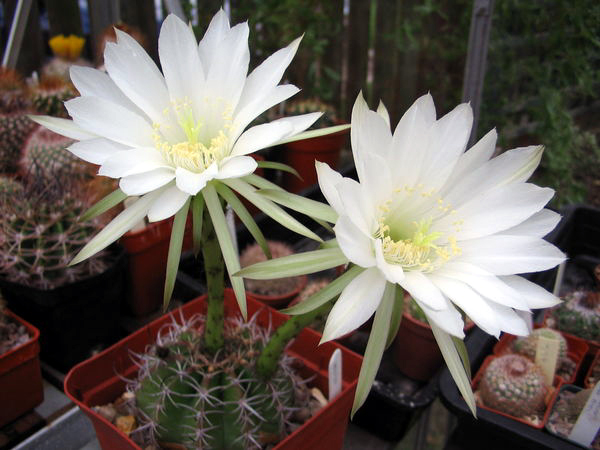|
Trichocereeae
Cereeae is a tribe of cactus, cacti belonging to the subfamily Cactoideae containing about 50 genera, divided in 2023 among six subtribes. Description Cereeae are tree-like or shrubby, sometimes climbing plants. Their mostly elongated to spherical, ribbed and thorny shoots are not articulated. The flowers, which usually appear on the side of the shoot, open during the day or at night. Their pericarpels usually have a few scales or are completely glabrous. The fleshy, berry-like, bursting or non-bursting fruits often have a blackening adherent flower remnant. The small to large seeds are oval. The hilum and micropyle of the seeds are fused, one appendage is absent. Taxonomy Phylogeny In classifications before the use of Molecular phylogenetics, molecular phylogenetic methods, Cereeae was one of nine tribes into which the subfamily Cactoideae was divided. Molecular studies found that these traditional tribes were not Monophyly, monophyletic. A broader Circumscription (taxonomy), c ... [...More Info...] [...Related Items...] OR: [Wikipedia] [Google] [Baidu] |
Aylostera
''Aylostera'', is a genus of cactus, native to central Bolivia and north western Argentina. ''Aylostera'' was formerly sunk into a broadly Circumscription (taxonomy), circumscribed genus ''Rebutia'', but Molecular phylogenetics, molecular phylogenetic studies from 2007 onwards showed that when defined in this way, ''Rebutia'' was not Monophyly, monophyletic, leading to the resurrection of ''Aylostera''. A 2023 classification of the tribe Cereeae placed it as the only genus in the subtribe Aylosterinae. It was formerly placed in the subtribe Rebutiinae. Description ''Aylostera'' species are small cacti with globular stems. The stems may or may not have ribs; this feature can vary even within a species. Their flowers are of various colours. A key feature that distinguishes ''Aylostera'' from ''Rebutia'' is that the Hypanthium, pericarpels and Receptacle (botany), receptacles (which together form a structure that is often referred to as the 'flower tube') are hairy, rather than Glabr ... [...More Info...] [...Related Items...] OR: [Wikipedia] [Google] [Baidu] |
Echinopsis
''Echinopsis'' is a genus of Cactus, cacti native plant, native to South America, sometimes known as hedgehog cactus, sea-urchin cactus or Easter lily cactus. , there are about 20 accepted species, ranging from large and treelike types to small globose cacti. The name derives from ''echinos'' hedgehog or sea urchin, and ''opsis'' appearance, a reference to these plants' dense coverings of spines. They are remarkable for the great size, length of tube, and beauty of their flowers, borne upon generally small and dumpy stems. Taxonomy Studies in the 1970s and 1980s resulted in several formerly separate genera being absorbed into ''Echinopsis''. When very broadly Circumscription (taxonomy), circumscribed, ''Echinopsis'' Sensu, sensu lato included over 100 species. Some genera have been absorbed and then accepted again. For example, the genus name ''Trichocereus'' was given to a number of columnar cacti in 1909 by Vincenzo Riccobono. The genus was subsumed into ''Echinopsis'' in 1 ... [...More Info...] [...Related Items...] OR: [Wikipedia] [Google] [Baidu] |
Trichocereinae
Trichocereinae is a subtribe of cactus that are particular to South America. There are 28 recognized genera in this subtribe. Description Arborescent to shrubby, Trichocereinae normally form unsegmented, spherical to columnar stems that are usually ribbed, tuberculate, or ribbed-warty. The small to fairly large, regular or bilaterally symmetrical flowers appear laterally or below the apex and open day or night. The flower cup is scaled or covered with hair. The fruits are fleshy to berry-like and sometimes burst open lengthwise. They contain small to medium-sized seeds that vary in shape. Hilum and micropyle of seeds are fused to united. Appendages are usually absent. A strophic is present in some. Genera The composition of the subtribes of the tribe Cereeae varies. The list below is based on genera accepted by Plants of the World Online . Most were placed in subtribe Trichocereinae by Lendel in 2013. ''Reicheocactus'' (listed here) was not included in Lendel's analysis, and was ... [...More Info...] [...Related Items...] OR: [Wikipedia] [Google] [Baidu] |
Browningia
''Browningia'' is a genus of cacti, comprising 11 accepted and 3 unresolved species. It is named for Webster E Browning (1869-1942), director of the Instituto Inglés, Santiago de Chile, Santiago, Chile. Description The bushy or tree-like, usually columnar species of the genus Browningia are branched, often have a well-developed trunk and reach heights of growth of up to 10 meters. The cylindrical shoots have a diameter of up to 50 centimeters. Large areoles sit on the numerous, low ribs. Areoles in the growth area are heavily spined, while areoles in the reproductive area usually have few or no spines. The tubular to bell-shaped flowers are white to purple and open at night. The areoles of the flower cup and the flower tube are (almost) bare. The flower tube is slightly curved. The usually small fruits are very different, as are the seeds. Species Species of the genus ''Browningia'' according to Plants of the World Online : References The Plant List.org: ''Browningia'' [...More Info...] [...Related Items...] OR: [Wikipedia] [Google] [Baidu] |



